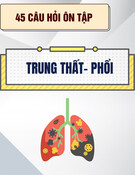
96
Journal of Medicine and Pharmacy, Volume 13, No.04, June-2023
Psychological counseling needs among middle and high school
students with separated/divorced parents in Hue city
Tran Binh Thang1, Ho Uyen Phuong1, Dinh Thi Lieu1, Pham Thi Thu Ha1, Chau Nguyen Dan1,
Nguyen Ngo Bao Khuyen1, Luong Thi Thu Tham1, Tran Thi Tra My1, Vo Nu Hong Duc1, Nguyen Thanh Gia1,
Nguyen Van Thong1, Nguyen Minh Tam1, Nguyen Minh Tu1*
(1) University of Medicine and Pharmacy, Hue University
Abstract
Background: Adolescents who live in incomplete families may be vulnerable to various psychological
effects, ranging from mild to complex. This study aims to examine the need for psychological counseling
among high school students whose parents are separated/divorced, and to identify factors associated
with this need. Methods: A cross-sectional descriptive study was conducted on 309 high school students
with separated/separated/divorced parents in Hue City. Results: The percentage of high school students
with separated/divorced parents who need psychological counseling accounted for 40.5%. The need for
psychological consultation about life skills and future orientation accounted for 54.4%, appearance and
physicality accounted for 37.9%, family relationships accounted for 33.0% and problems with reproductive
health and heterosexual friendship accounted for 31.4%. Factors related to the need for psychological
counseling include the time of parents’ divorce, close friendship relationship, problems with friends,
behavioral problems, violence, family quality and school quality, with a significance level of p < 0.05.
Conclusion: High school students with separated/divorced parents need psychological counseling, so it is
necessary to combine family and school to create a healthy environment for children.
Keywords: psychological counseling, needs, students, parents separated/divorced.
Corresponding author: Nguyen Minh Tu, email: nmtu@huemed-univ.edu.vn
Recieved: 2/2/2023; Accepted: 15/5/2023; Published: 10/6/2023
1. INTRODUCTION
Nowadays, issues related to mental health
among adolescents are increasing, especially for
children in separated or separated/divorced families
[1]. According to a study by Nguyen Thi Nhu Thuy
and colleagues (2019) on the psychological injury
of teenagers in disintegrated families in Ho Chi
Minh City, 16.1% of minors have psychological
manifestations [2]. Another study by Phillip A.
Radetzki and colleagues (2020) also found that
children whose parents were separated/divorced
were more likely to be affected by adverse mental
health outcomes than other children [3]. Children
affected by separated/divorced parents are at
high risk for a variety of mental health conditions
including emotional and behavioral disorders, poor
school performance, depression, anxiety, suicidal
ideation, suicide attempt, distress, smoking, and
substance abuse [4].
The fact shows that parents’ divorce has
significantly impacted teenagers’ perception of the
value of family and life. Teenagers tend to develop
more emotions and behavior during the post-
divorce period rather than before [5]. Different
psychosocial, physical, and transitional disorders
can occur in children affected by separated/divorced
parents [4]. Notably, at an older age, children tend
to seek emotional compensation and sharing with
a tendency to look outside of society, which can
lead to many other psychosocial problems [6]. The
behavior of children caused by divorce and conflict
between parents depends on the child’s age and
stage of development of the child, and it is important
to recognize them to intervene appropriately [7].
A study of psychology in the UK on adolescents
with psychological distress showed that those who
were advised had significantly reduced levels of
psychological suffering than those in the control
group [8]. Psychological counseling is an interactive
process between a professional with counseling
skills and ethics of the counseling profession and
a person with mental health difficulties in need of
assistance. Through the exchange, intimate sharing,
empathy, and acceptance of reality, self-discovery of
one’s potential to solve one’s problems is achieved
[9]. In Vietnam, there has been no research on the
mental health counseling needs of adolescents
with separated/divorced parents. That is why we
conducted research “Psychological counseling
needs among middle and high school students with
separated/divorced parents in Hue city” with two
objectives: (1) To examine the need for psychological






























